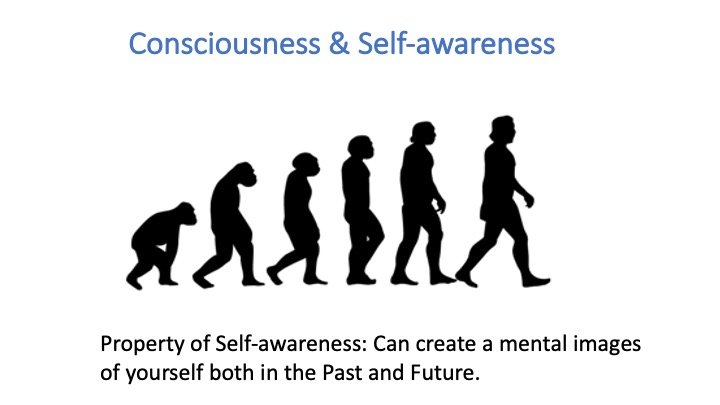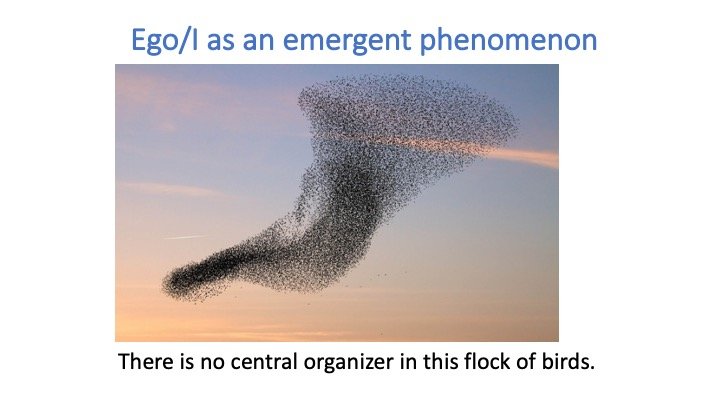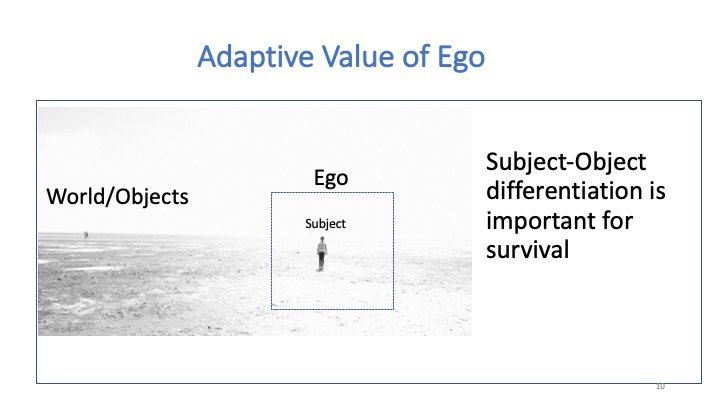Ego and Awakening
Twig
Ego is an emergent phenomenon
As discussed in my previous blog post, our ego is an emergent phenomenon which is a by-product of being aware. It is important to realize that the ego is an artifact that arises when we become self-aware, meaning that we can create mental images of ourselves, and imagine ourselves in the past and the future. As you can see from the picture below, there is no central organizer in the flock of birds below. It arises spontaneously from a multitude of factors, and even though from the outside it looks like this flock of birds has a central intelligence, it is a fallacy. Our ego arises similarly when our sense organs interact with the world around us.
Ego has adaptive value
It is important to realize that the ego has adaptive value and is responsible for subject-object differentiation. It is not possible for us to survive as a species if these boundaries drops suddenly as it has happened with the mystics of the past. Even the simple act of eating requires us to have ego boundaries because without knowing the difference between you the subject/body-mind and the world as an object, it becomes impossible to eat. Our mental map of the body is a creation of the ego. The ego protects us from the world around us and ensures the survival of the species.
It is not possible to destroy the Ego
It is important to realize that the ego cannot be completely destroyed because the end product of this description is death of the individual. You require a properly functioning ego for your survival. For you to do your work, make money, and relate to others you need to know the difference between you and other. Between you the subject and the objects around you.
In cases where the ego boundaries completely drop during meditative practices or in rare cases spontaneously, the practitioner requires someone to feed him, bathe him and take care of his basic needs. That is the reason a lot of these famous sages had people around them to take care of them.
Below is the report on Ramana Maharishi’s state after his enlightenment.
The sun’s rays never penetrated this cave, which was inhabited by ants and vermin. So absorbed was he [Ramana Maharishi] in meditation that he was completely oblivious when he was bodily carried out of the Pathala Lingam vault to the Subramanya Shrine. For about two months [Ramana Maharishi] stayed in the shrine absorbed in samadhi. Paying no heed to nourishment, food had to be put into his mouth, as he remained immersed in the effulgence of Bliss, barely conscious of his body, not speaking or moving, so that to onlookers it appeared to be the most intense tapas. It was not really tapas at all. He was simply ignoring the body he had ceased to need. He was already a Jivanmakta (liberated while alive) in unwavering consciousness of identity with the Self and had no karma left to wipe out, no further goal to attain.
As you see from the above report, once the ego boundaries drop, it becomes very difficult to even perform the simple act of eating, drinking and sleeping.
True Awakening is holding both perspectives (Relative and Absolute) simultaneously
As we discussed above, ego is not necessarily a bad thing. It is an artifact of our evolutionary processes, and is absolutely required for our survival as a species. Ironically, focusing and over emphasizing the removal of the ego as a barrier to enlightenment actually strengthens the ego. The important thing to give ego the proper place in the awakening process. We interact with the world through two perspectives, the relative (ego centered perspective) and the absolute (stillness) perspective. Over emphasizing either of these perspectives will lead to a very stilted view of reality.
Based on my discussions with my teachers, my understanding is that highest manifestation of these non-dual teachings is when the Absolute co-arises with the Relative. A lot of Dzogchen and tantric practices are focused on looking at the relative world from the perspective of the Absolute. The metaphor that I like to use is paying attention to the stillness that suffuses the whole world. This stillness is present in every movement of the mind and inseparable from our everyday consciousness. In Advaita, enlightenment is described as the reflection of the Absolute (Awareness) in a still mind [pratibimbavada] .If you recall from previous blogs, our true nature is Awareness and the nature of this Awareness is sat-chit-ananda (bliss).
That is why it is important to develop correct spiritual practices and work on fixing your karmic imprints which are not amenable to intellectual rationalizations. The knowledge that you are this blissful awareness will not take hold if the mind is susceptible to unconscious forces/trauma/desires and is unstable. That why the preliminary practices are so important in this path, with their main focus on creating a still and balanced mind. This takes work and is very difficult. Otherwise everyone would be enlightened without any effort.
.
A perfectly polished still mirror reflects everything without any blemish.




